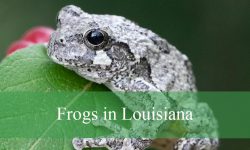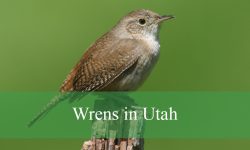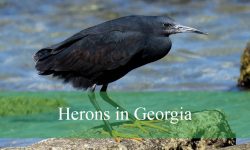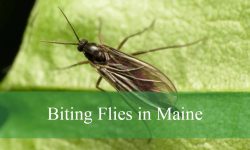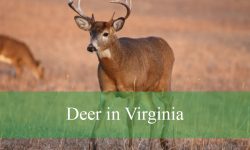Arizona’s desert landscapes and mountain woodlands are home to some of the most diverse and fascinating quail species in North America. These ground-dwelling birds are known for their plump bodies, distinctive calls, and head plumes that bob with every step.
From the familiar Gambel’s Quail seen in suburban yards to the elusive Mearns’ Quail of the oak forests, each species has adapted to a specific environment. Their appearances, behaviors, and habitats vary widely across the state.
In this guide, you’ll explore five species of quail found in Arizona, complete with pictures, identification tips, and details on where and when to find them in the wild.
Common Quail Found in Arizona
Gambel’s Quail (Callipepla gambelii)
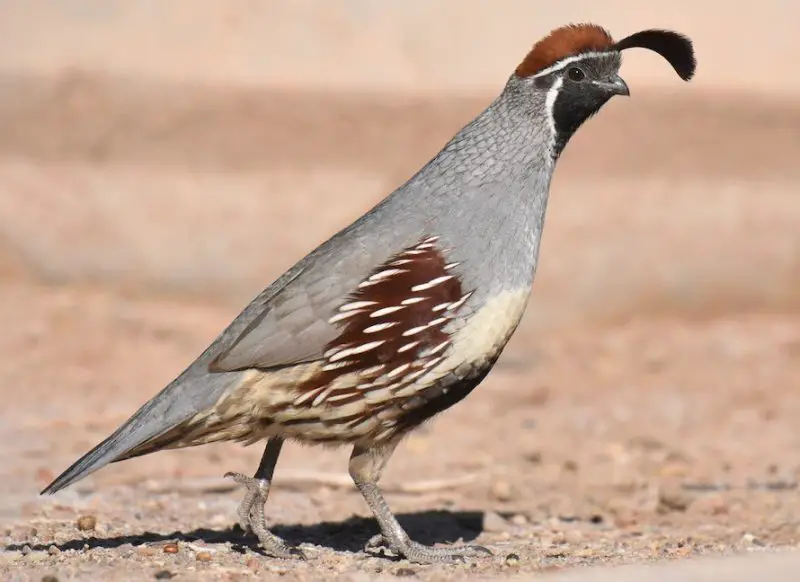
Gambel’s Quail is the most widespread and recognizable quail species in Arizona, especially prominent in the lowland deserts of the southwest. Males are striking with a bold black face, chestnut cap, and a comma-shaped black topknot that arches forward over the forehead. Females are duller, with grayish tones and a more subdued topknot, but both sexes share a scaled pattern on the belly. These birds are about 10–12 inches long and are known for their round bodies and short tails.
They are commonly seen in brushy desert washes, mesquite thickets, and residential areas with thick landscaping. Gambel’s Quail are highly social and often found in coveys—groups of 10 to 20 individuals—especially outside of the breeding season. They are ground dwellers, rarely flying unless startled, and prefer to run to cover when threatened. Their loud, descending “ka-KAA-ka” call is a familiar sound in desert regions.
Gambel’s Quail primarily feed on seeds, leaves, and cactus fruits, particularly the fruits and pads of prickly pear. They will also consume insects during the breeding season to meet the higher protein demands of nesting and raising chicks. Early morning and late afternoon are the best times to observe them foraging in open areas near dense shrubs or under cover.
A fun fact about Gambel’s Quail is their dedication to family groups. During spring, the female lays a large clutch of up to 15 eggs, and once hatched, the tiny chicks follow their parents in a tight line through the desert. The parents are attentive and will even perform distraction displays to lure predators away from their young.
Scaled Quail (Callipepla squamata)
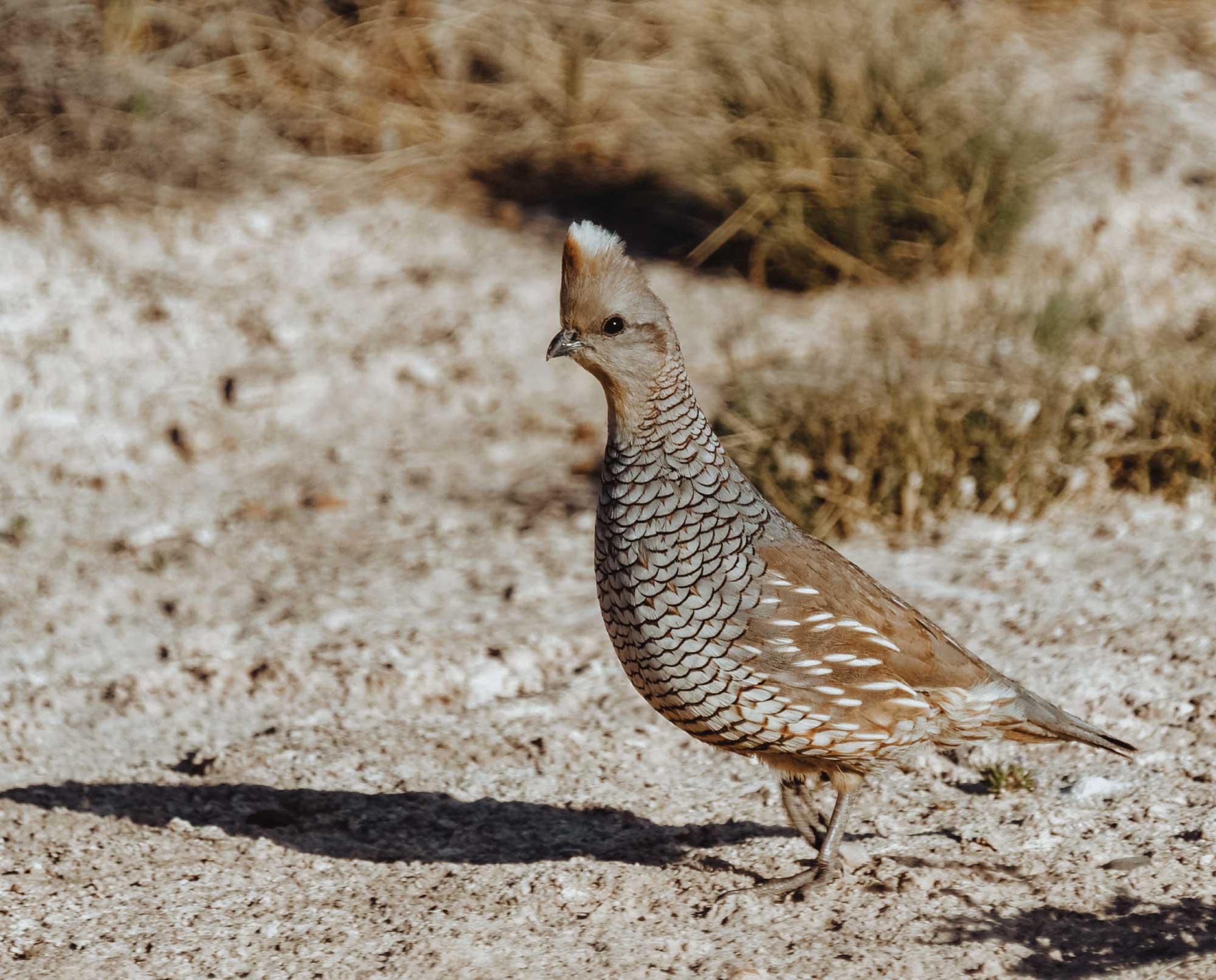
Scaled Quail, also known as Blue Quail, are medium-sized desert birds named for their unique “scaled” feather pattern across the chest, neck, and back. Their feathers have dark edges that create a scaly effect, and they sport a short white crest or “cotton top” that’s especially visible on alert individuals. Both males and females have similar coloration—a pale grayish-blue body with lighter bellies and rusty markings on the crown.
In Arizona, Scaled Quail are typically found in the southeastern part of the state, especially in open, arid grasslands, desert flats, and dry shrublands. Unlike Gambel’s Quail, which prefer dense vegetation, Scaled Quail are more tolerant of open habitats with scattered grasses and cacti. They are highly mobile on the ground and tend to form small coveys, especially outside the breeding season.
Their diet consists mostly of seeds, grasses, and forbs, but they also feed on insects during the summer months. Scaled Quail are strong runners and often escape danger by sprinting rather than flying. When flushed, they may burst into rapid flight before quickly dropping back into cover. They also require access to water sources and are often found near livestock tanks or desert springs.
A fun fact about Scaled Quail is that they sometimes perch on rocks, logs, or fence posts—behavior not often seen in other quail species. Their call is a distinctive “whock-whock-whock,” often heard early in the morning across dry grassland habitats.
Mearns’ Quail (Cyrtonyx montezumae)
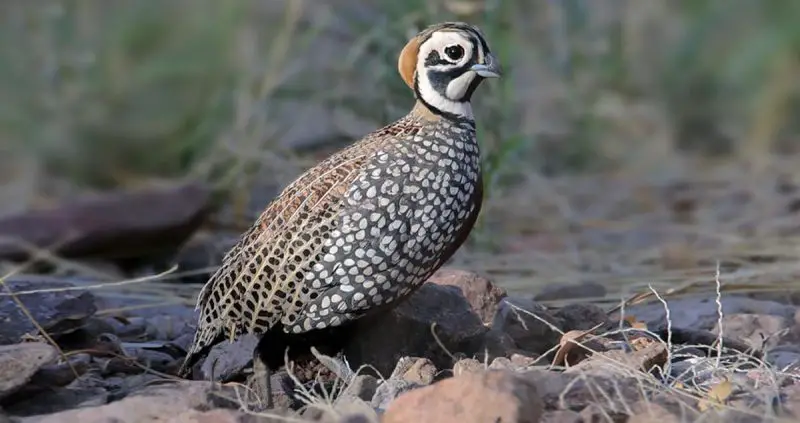
Mearns’ Quail, also called Montezuma Quail, is the most secretive and visually distinctive of Arizona’s quail species. Males are unmistakable with their bold black-and-white facial pattern, chestnut flanks adorned with white spots, and stocky, rounded bodies. Females are more subdued in tone but still possess intricate patterns that provide excellent camouflage in the forest floor litter. They are smaller than Gambel’s and Scaled Quail, measuring about 9–10 inches.
These quail inhabit the oak woodlands, pine-oak forests, and grassy foothills of southeastern Arizona, including the Huachuca, Santa Rita, and Chiricahua Mountains. They prefer areas with a mix of tall grasses and open woodland, where they can forage under the cover of vegetation. Unlike other quail, Mearns’ Quail are less likely to be seen running across open ground and more often sit tight until nearly stepped on, bursting upward in explosive flight only at the last second.
Their diet is highly specialized—they feed heavily on underground bulbs and tubers, which they dig up with their strong legs and claws. Insects are also part of their diet during the breeding season. They are often solitary or in small pairs and are difficult to locate except by sound or when flushed. Their call is a soft, whistling “three-note” that carries well in the quiet uplands.
A fun fact about Mearns’ Quail is that during the dry season, they rely almost entirely on moisture from bulbs and insects, rarely visiting open water. Their cryptic plumage and secretive behavior make them one of the most challenging birds to observe in Arizona, prized by birders and hunters alike.
California Quail (Callipepla californica)
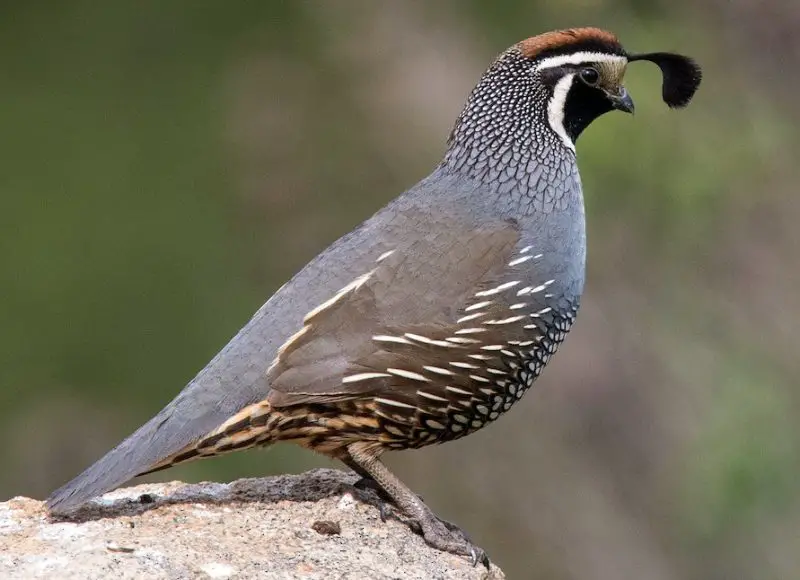
California Quail are more commonly associated with the West Coast but can be found in northwestern Arizona, especially in riparian zones, scrubby oak woodlands, and foothill chaparral. Slightly smaller than Gambel’s Quail, they are about 9–10 inches long and sport a distinct teardrop-shaped black plume that curves forward from the top of their head. Males have a black throat bordered by white and a scaled belly, while females are more uniformly gray and brown.
In Arizona, their range is limited to suitable habitats near water or higher elevations where shrubs and grasses are plentiful. They are most often seen in the Lake Havasu and Kingman areas, along with the Mojave Desert’s more vegetated patches. Like other quail, they are ground dwellers and rarely take flight unless alarmed. Their social structure includes coveys and strong pair bonds during the breeding season.
California Quail feed on a wide range of seeds, berries, and insects, often scratching the ground with both feet to uncover food. They will also forage on buds and green vegetation, particularly in spring. These birds are vocal and communicate with a series of calls, including the well-known “Chi-ca-go” call, used to keep the group together.
A fun fact about California Quail is that after hatching, the young are able to leave the nest within hours and feed themselves immediately. Both parents care for the brood, and they may even form “communal broods” with other families, resulting in flocks of 20 or more chicks guarded by multiple adults.
Masked Bobwhite (Colinus virginianus ridgwayi)
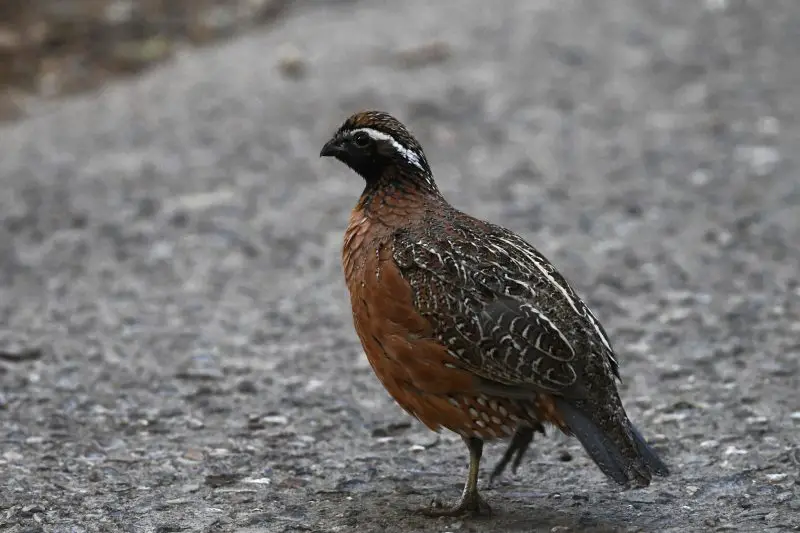
The Masked Bobwhite is a subspecies of the Northern Bobwhite and is one of Arizona’s rarest and most endangered birds. Males are easy to recognize with their black face and throat bordered by rich chestnut plumage on the breast and flanks. Females are more muted in tone, lacking the black mask but retaining warm brown tones with subtle streaking. These birds are small and round-bodied, typically 9–10 inches in length.
Historically, Masked Bobwhites were found across the Altar Valley in southern Arizona, but habitat loss and overgrazing caused a severe decline, and they were nearly extinct in the wild by the 1900s. Through captive breeding and habitat restoration, reintroduction efforts have taken place in the Buenos Aires National Wildlife Refuge, where ongoing monitoring and release programs aim to re-establish populations.
Their preferred habitat includes mesquite grasslands with scattered shrubs and a mixture of open ground for feeding and cover for protection. Masked Bobwhites feed on seeds, insects, and green plant material. Unlike other quail species in Arizona, their survival is more dependent on conservation management, as their habitat is now rare and fragmented.
A fun fact about Masked Bobwhites is that their recovery story has become a symbol of species conservation in the Southwest. Efforts to save this bird include the involvement of zoos, government agencies, and volunteers—all working together to bring this elusive quail back to Arizona’s landscape.
FAQs About Quail in Arizona
How many types of quail live in Arizona?
Arizona is home to five species of quail: Gambel’s Quail, Scaled Quail, Mearns’ Quail, California Quail, and the endangered Masked Bobwhite. Each species inhabits different regions and habitats across the state, from deserts to woodlands.
What is the most common quail species in Arizona?
The Gambel’s Quail is the most widespread and commonly seen quail in Arizona. It thrives in desert scrub, chaparral, and urban areas throughout the state, especially in the Sonoran Desert.
Where can I find Mearns’ Quail in Arizona?
Mearns’ Quail are found primarily in southeastern Arizona, in oak woodlands and grassy slopes of mountain ranges like the Huachuca, Chiricahua, and Santa Rita Mountains. They are elusive and well-camouflaged, making them difficult to spot.
Are Masked Bobwhites still found in the wild?
Yes, but only in limited areas. The Masked Bobwhite is a federally endangered species, with active reintroduction efforts focused in the Buenos Aires National Wildlife Refuge near the Arizona-Mexico border. Wild populations remain small and carefully managed.
How can I tell Gambel’s Quail and California Quail apart?
While both species have a curved topknot, Gambel’s Quail males have a black face and chestnut crown, while California Quail males feature a black-and-white scaled throat and bluish belly. Their ranges also differ: Gambel’s are widespread, while California Quail are mainly in northwestern Arizona.
Do quail in Arizona migrate?
Most Arizona quail are non-migratory, remaining in their home territories year-round. However, some species, like Scaled Quail, may shift elevation or move short distances depending on weather, food availability, or drought conditions.
What do Arizona quail eat?
Arizona quail primarily eat seeds, fruits, green shoots, and insects. Mearns’ Quail also dig for underground bulbs and tubers, especially during the dry season. Insects become a critical food source during nesting season for all species.
Are quail in Arizona good for birdwatching?
Absolutely! Arizona’s quail are popular with birders, wildlife photographers, and hunters alike. Their striking plumage, unique calls, and ground-dwelling habits make them fascinating to observe—especially during early morning or late afternoon hours.
What time of year is best for seeing quail in Arizona?
Fall and spring are ideal for spotting coveys of quail, especially Gambel’s and Scaled Quail. For Mearns’ Quail, the best viewing is during late summer to early winter when they are more vocal and active.
Are quail protected in Arizona?
Most quail species in Arizona are managed as game birds, with regulated hunting seasons and limits. However, the Masked Bobwhite is fully protected under federal law due to its endangered status, and it is illegal to hunt or disturb them.

